The Laws of Layering
By Karen Berger
Photographs by John R. Fulton Jr.
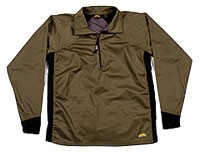 GoLite's WindStopper N2S Stealth ($139) lets you wear just one garment with no need to add or subtract layers, thanks in part to a liner fabric which quickly drives out perspiration moisture. 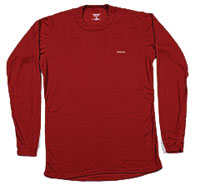 Patagonia's Capilene SW crew ($34) is a base layer garment that uses Capilene Silkweight fabric for fast wicking and drying of body moisture, while... 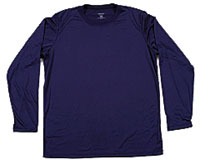 ...the Capilene LW crew ($30) features Capilene Lightweight, a base layer for rigorous aerobic activity. Both garments can be worn alone or under insulation and shell layers. 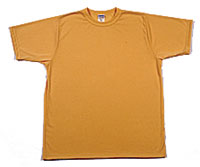 Wickers's Unisex Short Sleeve Jersey T-shirt ($18) is made from Comfortrel performance polyester. It feels like cotton but has "moisture management" properties that quickly wick moisture away from the body. 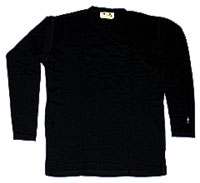 SmartWool's Aero L/S crew ($60) is a base layer made from soft New Zealand merino wool that helps regulate body temperatures in hot and cold climates. |
Camp clothing has gone high tech. Modern fabrics used in a layering system can keep you both warm and dry.
The next time you shop for hiking clothes, it may seem like a trip to an 11th-grade science lab. Like other camping gear, outdoor clothing fabrics have gone high tech.
A scratchy wool "union suit" may have kept granddad warm and dry, but today's fabrics are not only lighter and warmer, but also far less itchy. They are also faster drying, more durable, and better at wicking moisture away from your body.
But what is most surprising, these clothes are more likely to be made of recycled plastic soda bottles than from anything your grandfather would recognize as fabric.
First rule of fabrics
A layering system is key. But effective layering isn't just a matter of piling one item of clothing over another. What you put where is important, too.
The new fabrics—as well as new and improved old favorites—give you dozens of choices. Take time to experiment: Everyone's body retains heat and produces sweat a little differently. It may take some fine-tuning to come up with the perfect system.
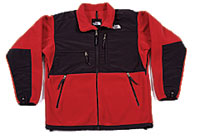 The North Face Denali jacket ($165) is made of 300-weight fleece and features a durable, water-repellent finish that makes it useful as an outer layer in light rain conditions. 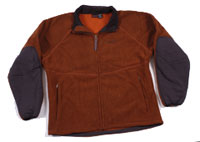 Marmot's McCloud fleece sweater ($115) uses Polartec 200, a medium-weight fleece, and also has an outer finish which sheds light rain. 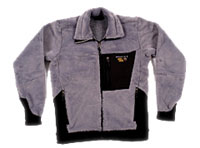 Mountain Hardwear's Monkey Phur jacket ($110) uses Polartec Thermal Pro, a non-laminated, durable fleece weighing just 70 percent of standard fleece, while... 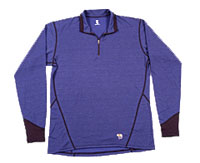 ...the eXtend Zip T ($60) outerwear features Polartec Power Dry fabric that dries fast, provides warmth, fights odor, and wicks away body moisture. 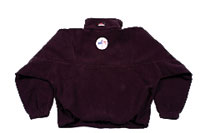 The Fleur-de-Lis fleece pullover ($55) is available from the BSA Supply Division and is made from extra-soft, 12-oz. Polartec fleece. |
Under layers
Your base layer is the starting point for moisture and temperature management.
These garments come in several different weights, ranging from lightweight to expedition-weight. Don't overdo it: Even if you plan to hike in subfreezing temperatures, expedition-weight under layers will make you overheat, unless you're headed for places with names like Denali or Everest.
Polypropylene is a common base layer fabric because it wicks sweat away from your body and helps keep you warm. It's inexpensive, but has two major drawbacks: It retains body odor in a big way, and it can't be washed in hot water or put in a clothes dryer because it will melt.
Polartec, a versatile fabric used in everything from base layers to insulation and weather protection, is a big step up: It doesn't retain as many odors, and it often has a brushed, comfortable inner surface.
Many manufacturers also offer proprietary blends. Examples include Wickers's Comfortrel, Patagonia's Capilene, and Mountain Hardwear's eXtend. All have good moisture transfer properties and don't retain odors.
For those who love wool, Smartwool's Aero crew is both a base layer and a shirt for aerobic activities. Unlike synthetics, SmartWool fibers capture perspiration in the vapor state, which minimizes odors. The wool itself is a soft New Zealand merino wool that is virtually itchless. And it can be safely put in a clothes dryer (unlike older wool clothing).
Another entry into the base layer field is GoLite's Stealth. The Stealth reinvents the concept of a base layer by using a fabric made by W. L. Gore and Associates. GoLite's WindStopper N2S sandwiches three layers into one: a durable outer layer, a wind blocking mid-layer, and an inner wicking layer.
Insulating layers
When it comes to insulation, most hikers have at least one synthetic pile or fleece article of clothing.
Fleece pullovers, vests, zip-up jackets, and pants are available in a variety of weights, measured usually between 100 and 300. The higher the number, the heavier—and warmer—the jacket.
The lightest is 100-weight, useful in pullovers and middle layers as vests, or as an outer layer in warm temperatures. A good all-around choice is 200-weight fleece, because it can be used as either a heavier pullover or a jacket. A 300-weight fleece jacket is so warm that you would use it more often in camp or during rest breaks than while working up a sweat on the trail.
Microfleece jackets have a tighter weave and block wind better, and pile has a rougher texture and tends to be warmer and bulkier.
Some manufacturers have added other features to their fabrics, like stretchy, form-fitting microfiber or water-repellent treatments. For example, The North Face's Denali jacket is a 300-weight fleece that features a durable, water-repellent finish, making it useful as an outer layer in light rain conditions. Two-way pit zippers allow excess heat to escape.
Marmot's McCloud fleece sweater is a 200-weight fleece with similar features. For the late fall and in early winter, you'll probably need at least two insulating layers, in addition to your base layer. A good combination is a microfleece pullover and a 200- or 300-weight jacket.
And don't forget about your legs: While most hikers don't hike in fleece during the day, fleece pants can be cozy on cold evenings. You'll also use fleece for hats, mittens—and even socks for camp wear.
Insulating fills
Another way to stay warm is with a jacket filled with down or some other insulating fill. Following the layering principle, you don't want one of those heavy-duty jackets that could practically double as a sleeping bag. Instead, have a lightweight jacket that can be part of a layering system.
While down is highly compressible and extremely warm, it does not insulate when wet. Down works better in snow, which can be brushed off. If you're unsure of whether to expect rain or snow, you might opt for synthetic fill instead.
Karen Berger is the author of nine books on outdoor adventure, including More Everyday Wisdom (Mountaineers Books). Visit her at www.hikerwriter.com.
October 2003 Table of Contents
Copyright © 2003 by the Boy Scouts of America. All rights thereunder reserved; anything appearing in Scouting magazine or on its Web site may not be reprinted either wholly or in part without written permission. Because of freedom given authors, opinions may not reflect official concurrence.